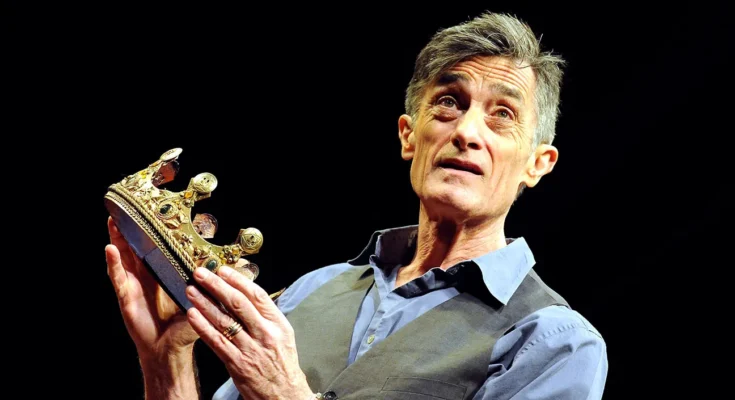Roger Rees was a stage artist who left a lasting impact on the entertainment industry. It has left an exceptional, versatile, and dedicated legacy in the history of the entertainment world.
From a commanding phase in London’s West End to captivating viewers on Broadway and far away, Rees’ occupation bridged decades and surrounded an affluent tapestry of roles that showcased his extraordinary range as a performer.
In 1944, on May 5th, Aberystwyth, Wales-born Rees’ quest into the acting world started early. He honed his skills and laid the foundation for a prolific career through training at RADA, the most reputable Royal Academy of Dramatic Art in London.
Roger Rees career.
During his stay with the Royal Shakespeare Company (RSC), Rees’ performance of the title character in the 1980 production of “The Life and Adventures of Nicholas Nickle” became the turning point in his career. He turned out to be perfect as chief, hailed widely, and the actor managed to get laurels from both Olivier and Tony for being the best actor in a play. In addition to his standing as a prominent figure in the theater industry, Rees became known to spectators on both sides of the pond (the Atlantic) through this groundbreaking play.
Roger Rees’s career in theater.
Rees was commendably well-stocked for that career because he could smoothly transition from the theatrical stage to the television screen and bring the diverse and dimensional characters to life with aplomb. On Broadway, he steps in shows, making one award for a performance—a nomination for a Tony for “The Rehearsal,” “Indiscretions,” and “The Visit.” Shakespearean educated his roles, ranging from modern chicks cringing at his characters, Moses, Ganghjitter, and many other sills reflecting his versatility of artistic craft.
Roger Rees’s work in film and television.
Besides the theater, Rees also did a considerable amount of work in films and television, where he played in many projects, numerous of which he did to exhibit his talent and versatility. From his memorable turn as the Sheriff of Nottingham in Mel Brooks’ Robin Hood: May it be his portrayal of Barf the Eternal in “The Eternal” or Lord John Marbury on “The West Wing,” his on-screen presence, in every role, has been able to draw the audience and has also left an indelible impression.
Roger Rees, director of cinema.
Roger Rees was an actor who was not only recognized for his wondrous works but also respected for his dabbling in directing and starting an academy where he instructed talented artists. Among other things, such qualified and committed work as the mentoring of young and talented people and creative nurturing was a clear testimony to the director’s deep involvement in cinema and his desire to leave a neat and ripped memory of the theater.
How Roger Rees inspired the world.
Regrettably, the world lost this remarkably gifted human being on July 10th, 2015, but his legacy continues to influence and inspire the world. His imprint on the performing arts field is unquantifiable, and his kind heart is still heavily felt by the ones who worked, played, and mourned alongside him. Nevertheless, his spirit is eternalized by the breadth of his output, which remains a demonstration of his ability, his torch, and the lasting charge he left the world with.

How Roger Rees inspired the audience.
In the time we take to celebrate Roger’s life and career, we are made to consider how potent storytelling is and how an individual is powerful enough to influence the world’s fortunes through art. His demonstrations will continue to manage and ignite audiences for the next generation, and they will spread the spirit that he lives on in the hearts and souls of the ones who come to the theater. Roger Rees, whose brightness had vanished from the stage, will live on in history books, not only for his peerless abilities but also for his lasting imprint on entertainment.
Roger Rees social work.
Most importantly, his impact went far beyond merely being a theater and film actor; Roger Rees was also a devoted activist on social issues and a supporter of various charity projects. Through the whole life of Rees, he gave his voice and support to different groups, leading to a better life for people, such as HIV/AIDS, LGBTQ+ groups, and arts education. His charities emphasized how he truly felt that the arts were the driving force behind societal changes and that looking after the interests of society was the responsibility of the influential ones.
Roger Rees fundraising.
Right at the top of the list of Rees’ activism commitments was his role in creating and sustaining awareness of the HIV/AIDS epidemic and advocating for policy measures that would deal with this disease. In those times of the AIDS epidemic occurring in the 1980s and 1990s, Rees was acknowledged for his long-term dedication to crisis fundraiser organizations such as The Foundation for AIDS Research and Broadway Cares/Equity Fights AIDS. He attended plenty of benefit shows and events. He used his talent and connection to the public to illuminate an issue that can be deadly, which was the imperative of research and efficient and responsive support services.
LGBTQ+ community’s awareness.
Another issue to which Rees devoted a lot of efforts was the LGBTQ+ community’s awareness about HIV/AIDS and, in general, their equal rights. Being an open-minded gay man in the showbiz world, he had to fight some challenges and prejudice, but he remained merciless towards being authentic and being the representative. Rees moved around with courage and openness; his example gave many people a roadmap for living actual and comfortable lives. He employed his public position to promote an LGBTQ+ community that was well-known and appreciated for its visibility and acceptance.
Roger Rees’s role in educational development.
Besides, Rees identified the crucial role the art of education plays in developing new talents and inspiring children. He was an excellent champion for arts education in schools; he felt that the arts would enhance and cultivate character and development in school. Rees showed interest in groups that specifically focused on incorporating arts education into underprivileged areas and created a platform with arts availability and opportunities for young generations.
Roger Rees rewards for achievements.
Additionally, Roger Rees received several awards for his skills, commitment to art, and advocacy work during his career. Besides the Olivier and Tony Awards, he got them because of his acting; he also received the John Houseman Award for his willingness to help those who make a living in theatrical organizations. Moreover, he was appointed CBE (Commander of the Order of the British Empire) for his contribution to the world of drama.
Conclusion:
As we revisit his public life and his legacy, we may be reminded that his everyday life can transform the world through creative thinking, advocacy, and philanthropy. Which of the qualities above is that of his undeniable talent, passion, and commitment to making a difference to people worldwide? Although he is no longer with us in person, his soul still lives on in all his works and wherever his fans are. During his long career, he reached and touched so many people. Roger Rees, no doubt, has left the stage for good, but his legacy will be a shining beacon that will help generations appreciate art, share kindness, and prove that anything is possible.



